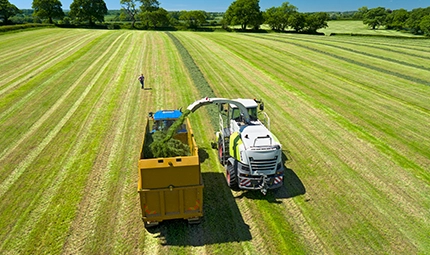With summer well underway, now is the perfect time to focus on selecting and planting the right grass seed variety to ensure optimal grazing before the end of the year. Delaying this process can lead to missed opportunities for high-quality forage production. Here’s an in-depth guide to help you choose the best grass seed variety and ensure successful establishment and grazing.
Why Reseeding Now is Crucial for Your Pasture?
Reseeding your pasture by the end of August is crucial for several compelling reasons. First and foremost, timely reseeding allows for optimal establishment before the onset of winter, ensuring robust growth and resilience throughout the grazing season. It sets the stage for enhanced grass quality, which directly translates to improved livestock performance and productivity. Moreover, early reseeding maximises the utilisation of available growing conditions, leveraging favourable soil temperatures and moisture levels to promote strong root development and rapid seedling establishment. By acting now, you’re investing in the future health and productivity of your pasture, paving the way for increased forage yields and cost-effective feed production. Here is a breakdown of the most important benefits of reseeding now:
Optimal Growing Conditions
Soil temperatures are warm, and moisture levels are generally favourable in late summer, creating ideal conditions for seed germination and growth.
Establishment Time
Planting in August allows the grass to establish a strong root system before winter, ensuring it’s ready for grazing in the following months.
High-Quality Forage
Early reseeding results in higher quality and quantity of forage, which can be grazed before the end of the year.
Resilience
A well-established pasture is more resilient to weather extremes and can maintain productivity during dry spells or colder weather.
Selecting the Right Grass Variety
Choosing the right grass variety is essential for maximising yield, quality, and persistence. Here are key factors to consider:
Yield and Quality
Select varieties that produce high yields of quality forage. Look for grasses that have been tested and proven to deliver consistent results, such as those listed in Teagasc Pasture Profit Index (PPI).
Grazing Utilisation
Choose varieties with high grazing utilisation rates. These varieties are more palatable to livestock, ensuring that more of the grown grass is consumed. For example, Xenon and Aspect are among the top varieties for grazing utilisation.
Persistence
Opt for grass varieties known for their persistence. This ensures that the sward remains productive over several years, providing a good return on investment.
Seasonal Performance
Consider the seasonal growth patterns of different varieties to ensure a consistent supply of forage throughout the grazing season.
Recommended Varieties
Teagasc’s Pasture Profit Index (PPI) highlights the top-performing grass varieties in Ireland. Some of the highest-rated varieties include:
- Xenon: Known for its excellent grazing utilisation and persistence. It has a high PPI score and is favoured for its ability to support high animal performance.
- Aspect: Highly palatable and performs well in grazing trials. It ranks high in the PPI for grazing utilisation and digestibility.
- Nashota: A NxGen tetraploid variety with high-quality and good grazing utilisation. It combines the benefits of traditional tetraploids with a denser growth habit.
- Bowie: An ultra-late heading variety with excellent quality. It provides good ground cover and is ideal for extending the grazing season.
These varieties, especially when used in a mixture, provide a balance of yield, quality, and persistence, ensuring a productive and resilient pasture.

Preparing for Reseeding
Preparing for reseeding involves several critical steps to ensure successful establishment and long-term productivity of your pasture. From soil preparation to seed selection and timing, each aspect plays a crucial role in maximising the benefits of reseeding for your farm.
Soil Testing
Conduct a soil test to check for pH levels and nutrient availability. This will help you apply the necessary fertilisers to create optimal conditions for seed growth. Aim to correct any pH imbalances by applying lime if needed.
Seedbed Preparation
Prepare a fine, firm seedbed to ensure good seed-to-soil contact. This promotes uniform germination and strong root development. Consider methods such as disc harrowing and power harrowing to achieve this.
Sowing
Sow the grass seed at the recommended rate. This varies by variety, so follow the guidelines provided by your seed supplier. Typically, seeding rates are around 14 kgs per acre.
Post-Sowing Care
After sowing, it is crucial to manage weeds by applying post-emergence herbicides when weeds are at the seedling stage – it’s particularly important to target docks at this early stage. Carefully manage grazing on newly reseeded areas to promote tillering and the establishment of clover if it is included in the mix. Grazing should be light initially and gradually increase as the sward becomes more established.

Maximising Grass Utilisation
To make the most of your reseeded pasture, follow these key practices:
Grazing Management
Try to graze at least once before the end of the year, ensuring conditions are not either extremely wet or extremely dry to avoid damage. Graze down to lower residuals in early spring to promote three-leaf growth and higher quality forage. This encourages the sward to grow densely and increases the amount of palatable forage available.
Measure Residuals
Focus on measuring residuals rather than yield to manage the sward effectively. This helps in maintaining the desired sward height and promotes better regrowth.
Reseeding Plan
Aim to reseed 25-30% of your grazing platform each year to maintain high productivity and forage quality. This rotational approach ensures that you always have a portion of your pasture in peak condition.
Incorporating Multi-Species Swards
Consider incorporating multi-species swards into your grazing platform. Multi-species swards are a sustainable source of high-quality forage that offer several benefits:
Nutrient Efficiency
Multi-species swards can significantly reduce the nitrogen fertiliser requirement, as legumes within the mix fix atmospheric nitrogen. This leads to cost savings and environmental benefits.
Animal Performance
These swards produce highly digestible forage rich in minerals and high in protein, which can enhance animal health and performance.
Resilience
Multi-species swards are more resilient to drought and other adverse conditions, ensuring a steady supply of high-quality forage throughout the grazing season.
Managing Clover in the Sward
The incorporation of white clover into grass swards can significantly reduce reliance on inorganic nitrogen fertiliser and increase the financial and environmental sustainability of Irish farms. White clover is highly digestible, with crude protein content averaging over 20%.
Benefits of white clover include:
- Offsetting up to 150 kg N/ha per year in inorganic nitrogen fertiliser
- Increasing dry matter intake by 1.5 kg per cow per day
- Enhancing milk solids by 30 kg MS/cow per year
For maximum benefit, manage the sward to maintain a 20-30% white clover content. White clover is included in all Specialist Nutrition grass mixtures, and a high-yielding White Clover Blend Oversow is also available.
Conclusion
Selecting and planting the right grass seed variety before the end of August is essential for maximising grazing potential before the end of the year. By following these guidelines and choosing top-performing varieties, you can ensure a productive and high-quality pasture that supports optimal animal performance.
Don’t delay — contact Specialist Nutrition today to find the best seed for your farming system. Our team is here to help you achieve your production goals and maximise the value of your grazing platform.





